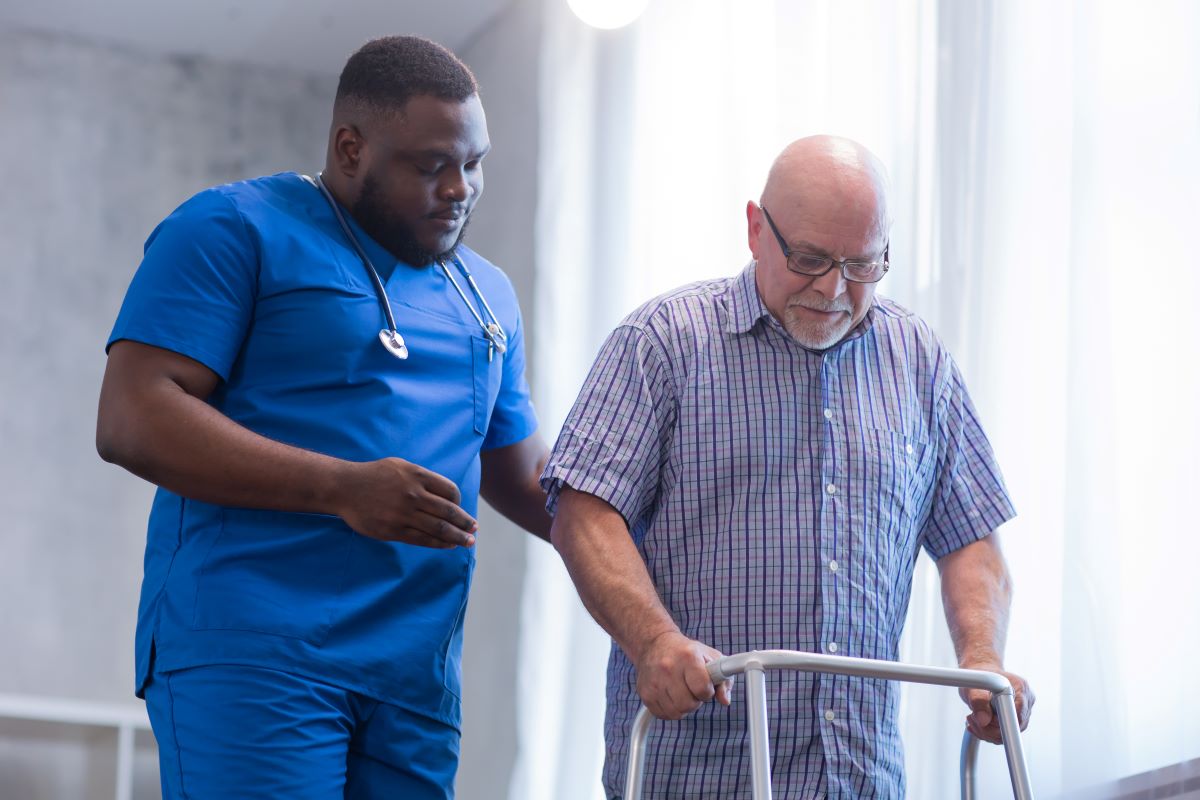Using Universal Fall Precautions: Facility Guide and FAQ

Falls are one of the most common yet preventable incidents that occur in hospital settings. Nearly 1 million patients fall in the U.S. each year, resulting in roughly 250,000 injuries and 11,000 deaths. To combat this issue, leading health organizations recommend that healthcare facilities of all types implement universal fall precautions to protect all patients, regardless of their risk of falls.
As a facility leader, understanding how to standardize fall precautions is crucial for keeping your patients safe. To help you strengthen your fall prevention policy and procedures, we’ll answer some of the most frequently asked questions about universal fall prevention strategies and provide tips for applying them in practice.
What Are Universal Fall Precautions?
Universal fall precautions refer to fall prevention strategies that apply to all patients at all times, regardless of a patient’s risk of falls. They’re essentially a list of interventions that all hospital staff — including non-clinicians — must be aware of and put into practice each time they interact with a patient.
What Are Common Universal Fall Prevention Strategies?
Each facility develops its own set of universal fall prevention strategies based on the needs of its patient population. However, for those interested in learning how to prevent patient falls in the hospital setting, the Agency for Healthcare Research and Quality (AHRQ) provides the following guidelines:
- Familiarize the patient with the environment.
- Teach the patient how to use the call light.
- Ensure the call light is within reach.
- Keep the patient’s personal items within safe reach.
- Have handrails in patient bathrooms, rooms, and hallways.
- Place the hospital bed in a low position when a patient is resting.
- Raise the bed to a comfortable height when the patient is getting out of bed.
- Keep hospital bed and wheelchair brakes locked when stationary.
- Keep non-slip, comfortable, well-fitting footwear on the patient.
- Use night lights or additional lighting in patient rooms.
- Keep floor surfaces clean and dry.
- Keep patient care areas uncluttered.
- Follow safe patient handling practices.
Why Are Universal Fall Prevention Precautions Necessary?
Implementing universal fall prevention measures is an important part of building a culture of safety for patients — which extends to staff, visitors, and other stakeholders. There are many fall hazards that can arise in hospital settings, such as wet floors or broken lights. If these hazards are left unchecked, anyone can be susceptible to falling as a result. By training staff to eliminate these risks in their day-to-day work, facilities can help reduce the rate of preventable falls and injuries.
How Can Leaders Implement Universal Fall Precautions in Hospitals?
Beyond standardizing a list of fall precautions, it’s important to understand how to streamline these precautions in practice. Follow these tips to ensure that your universal fall prevention strategies are being implemented effectively at your facility.
1. Provide Training for All Patient-Facing Staff
Keep in mind that universal fall prevention strategies apply to all patients, which means that all staff who interact with patients — even briefly — should be aware of them. It’s important to provide regular training to ensure your staff understand how to incorporate these precautions into their work. At baseline, this training should include:
- An overview of your facility’s universal fall prevention precautions.
- Staff members who are responsible for checking each precaution.
- How often each precaution should be assessed and reinforced.
- How precautions should be documented in the medical chart.
2. Implement Hourly Rounding
Many precautions require staff to check in on a patient throughout the day and night. Be proactive about these checks by implementing hourly rounding. This ensures that all precautions are put into place at all times. This type of rounding is most commonly carried out by a combination of nursing staff and assistive personnel.
When assigning staff to conduct hourly rounds, it’s also important to have a structured protocol in place. Many facilities use the 5 P’s of fall prevention, which emphasizes a list of items for staff to mentally remember and review for each patient during rounds. This can be adapted to fit your facility’s needs, but the following table provides an example of what this protocol can look like.
| 1. Pain | Conduct a pain assessment and provide medication as needed. |
| 2. Position | Ensure the patient is in a comfortable and safe position. |
| 3. Placement | Make sure all essential patient items are placed within reach. |
| 4. Pumps | Check that the IV pump is working and in a proper position. |
| 5. Potty | Ask the patient if they have bathroom needs and assist them as necessary. |
3. Conduct Regular Environmental Inspections
In addition to checking on patients, it’s important to regularly scan the environment for potential hazards. Unit managers and facility engineers should jointly conduct environmental inspections to ensure that anything requiring maintenance is fixed in a timely manner. The CDC provides a Falls Prevention Checklist that you can consider adapting for your facility.
What Is a Targeted Fall Prevention Strategy and How Can it Help Patients At High Risk?
Universal fall precautions are a foundational part of evidence-based fall prevention in hospitals. However, there are other key measures that are needed to protect patients who may be at high risk. Fall prevention interventions for those with a history of or predisposition for falling can include:
- Fall risk assessments: Assessing a patient’s fall risk is necessary to individualize care. Consider routine use of evidence-based fall assessments, such as the Morse Fall Scale or the Johns Hopkins Fall Risk Assessment Tool.
- Care planning: After conducting a risk assessment, staff should implement additional nursing interventions to prevent falls in older adults and others who may be high risk.
- Post-fall assessment: Patients who have experienced a fall should be assessed and treated in a timely manner to prevent further harm.
- Action plans: If falls are still regularly occurring at your facility, it’s important to create a strong action plan to improve your fall prevention strategies and protocols.
Discover More Ways to Build a Culture of Safety
Now that you know how to implement universal fall precautions, you may want to take your safety protocols to the next level. Not sure where to start? Our team of clinical and legal experts has crafted dozens of guides with practical insights and tips on managing a facility — all at no cost to you.

